When people think of volcanoes, they certainly aren’t picturing them erupting in Alaska, but they should be. Alaska is home to more than 130 volcanoes, with 50 active in the last 300 years.
Alaska is cold and isolated, making it the perfect place for volcanic eruptions that won’t interfere with day-to-day life. Volcanic ash is an issue for passing aircraft and can clog their engines and cause them to fail.
That’s right, there have been volcanoes actively erupting in Alaska. There were even three erupting simultaneously in 2021. These volcanoes are Great Sitkin, Pavlof, and Semisopochnoi, and Pavlov shows signs of potentially becoming active.
There have been eruptions every year since the early 1900s.
How Many Volcanoes Are In Alaska?
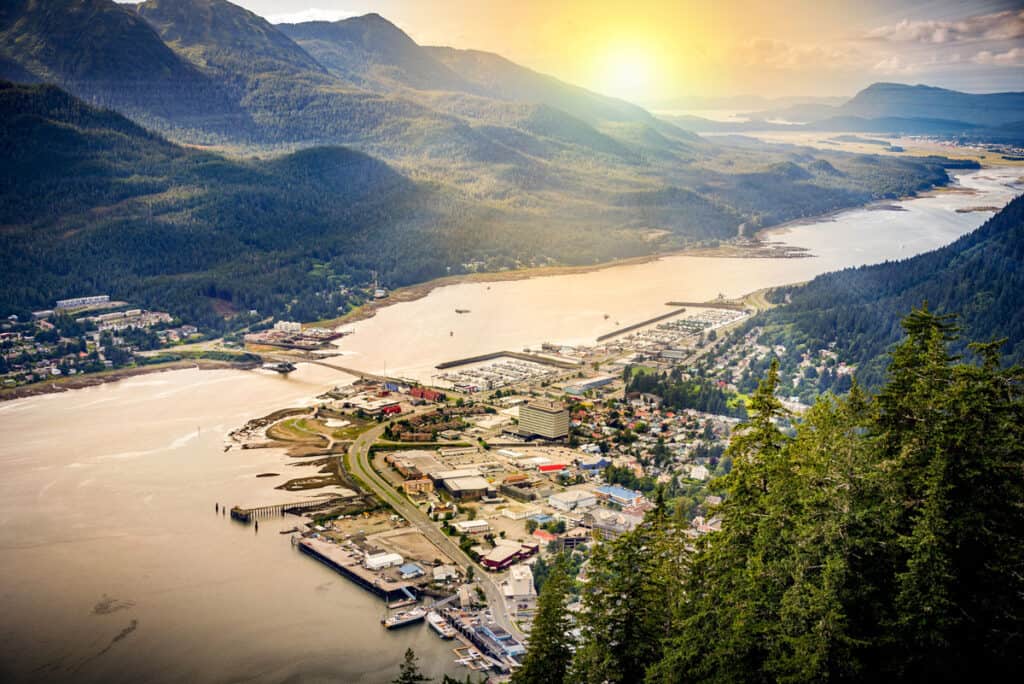
Alaska is loaded with volcanoes.
©iStock.com/chaolik
Alaska is loaded with volcanoes, there are more than 130 of them, and a considerable chunk of them have been active in the last few hundred years. At the end of this article, there will be a list of all of them, but we didn’t want to overload you so soon.
In 1953 Mount Spurr erupted, spilling ash over Alaska’s largest city, Anchorage. In 1997 it erupted three more times, and the air was uninhabitable for a few days. Most of the 130 volcanoes are located in the Aleutians further out, but a few are near Anchorage.
As the largest city, it is no surprise that Anchorage has the highest population in the state at almost 289,000 inhabitants, while the entire state of Alaska has a total population of around 736,556. People tend to group together, so there is plenty of unoccupied space out there.
The Aleutian Islands are islands that branch off from Alaska and break up the space between the Pacific Ocean and the Bering Sea. These islands all have volcanoes, some of which are active. People don’t live out here, so the only potential danger is getting clogged with ash in the airspace.
Alaska also has the Alaska Volcano Observatory (AVO), which helps keep track of everything going on with the volcanoes. Up to 90 of these volcanoes have had volcanic activity in the last 10,000 years, which is huge.
Alaska has always been a busy volcanic epicenter, and plenty of volcanoes need to be monitored continuously, as some are very active.
What Volcanoes Are Active In Alaska?
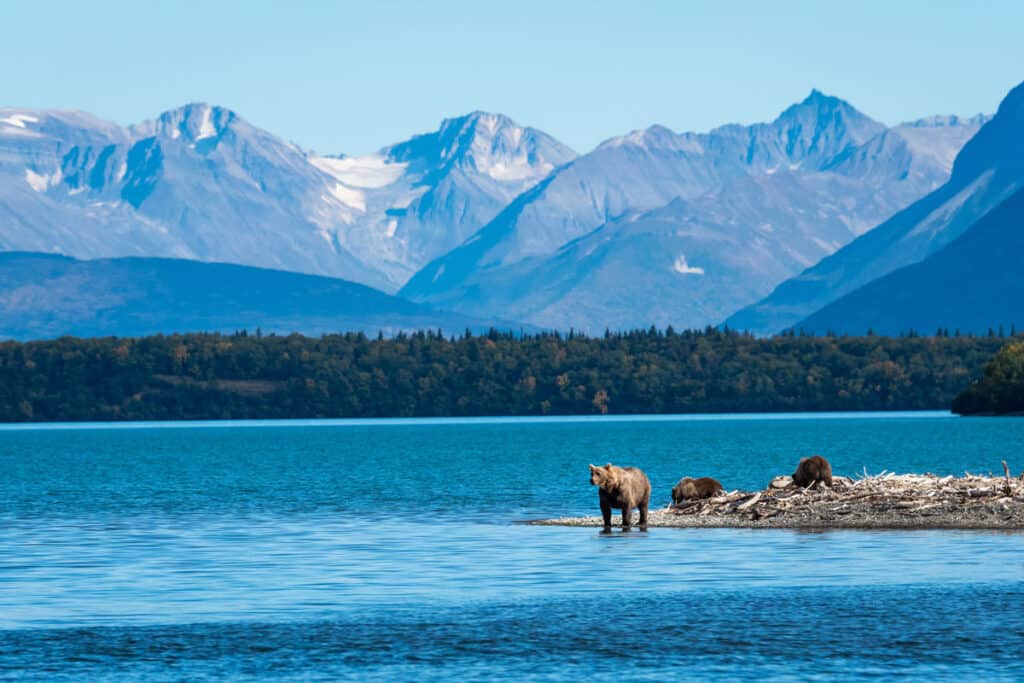
Alaska has always been a busy volcanic epicenter.
©iStock.com/N8tureGrl
So, of course, Alaska would have multiple active volcanoes, considering how many they have. There are ten active volcanoes, and they include:
- Akutan
- Bogoslov
- Cleveland
- Gareloi
- Great Sitkin
- Makushin
- Okmok
- Pavlov
- Shishaldin
- Veniaminof
There are three types of ways to categorize the life of a volcano: active, dormant, and extinct.
A volcano can be considered active when it’s had recent eruptions, as in the last 6,000 or so years. Dormant volcanoes have had volcanic activity within the last 10,000 years.
Extinct volcanoes have either not had volcanic activity in the last 10,000 years or can be confirmed extinct because they no longer have access to magma chambers beneath them, which can happen as magma and vents shift over time.
Vents are cracks or fissures from which the magma and gasses escape, and volcanoes form over them from the debris they end up spewing out. Once the magma escapes the curst of the earth, it becomes lava.
Akutan

Akutan is a strato-volcano, growing over time with layers of lava and ash.
©photo by Jerry Chisum (Mark Airways), 1987 (courtesy of John Reeder, Alaska Div. Geology & Geophysical Surveys) / public domain – License
The Akutan is a strato-volcano, a volcano that has grown over time thanks to layers of lava and ash. They tend to be welded together instead of cinder cone volcanoes built up of loose pyroclastic material.
This volcano was last active in 1992 and currently has normal activity levels recorded.
Bogoslof

Bogoslof was last active as recently as 2016.
©T. Keith, U.S. Geological Survey / This image is in the public domain in the United States because it only contains materials that originally came from the United States Geological Survey, an agency of the United States Department of the Interior. For more information, see the official USGS copyright policy.
This is yet another strato-volcano and was last active as recently as 2016. It erupted in the ocean and formed a new lava dome. A lava dome is when lava spills outward but piles up together and forms a dome that eventually grows solid.
Cleveland
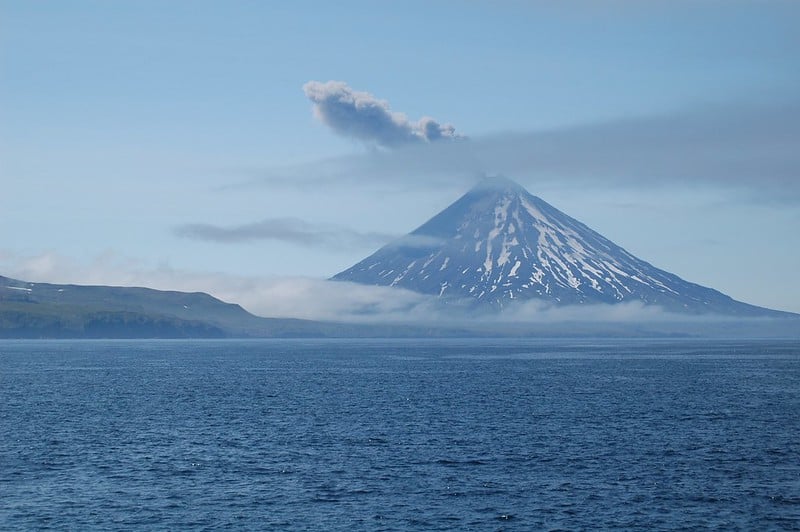
Mount Cleveland is a classic cone volcano that last erupted in 2001.
©NOAA Photo Library / flickr – License
Mount Cleveland also had its latest activity in 2016 and is a volcano in the Aleutian Islands, severed neatly from the mainland of Alaska. It looks like a classic cone volcano that last erupted in 2001, spilling out ash plumes and interfering with airplanes.
Gareloi

Gareloi was most active in the early 1900’s.
©Michelle L. Coombs (USGS) / This image is in the public domain in the United States because it only contains materials that originally came from the United States Geological Survey, an agency of the United States Department of the Interior. For more information, see the official USGS copyright policy.
Gareloi has not had activity since 1996 and is another strato-volcano. It is located on Gareloi island and was most active in the early 1900s, where it built much of its makeup of alternating lava flows and pyroclastic debris.
Pyroclastic debris are bits of rock and structure that the lava pushes up and outward during an eruption. It is loose material driven together by pressure.
Great Sitkin

Great Sitkin is currently being observed through seismic monitoring.
©photomatz/Shutterstock.com
This volcano is currently being observed. Its last recorded activity was on June 1, 2019, and is seismically monitored. It occupies the Great Sitkin Island and is another strato-volcano with a lava dome. It also has a caldera.
A caldera is a crater that forms when a lava eruption is strong and topples part of the cone. The material welds together and makes a crater. Some can be very deep, but most are shallow because the top part of the volcano collapses.
Makushin
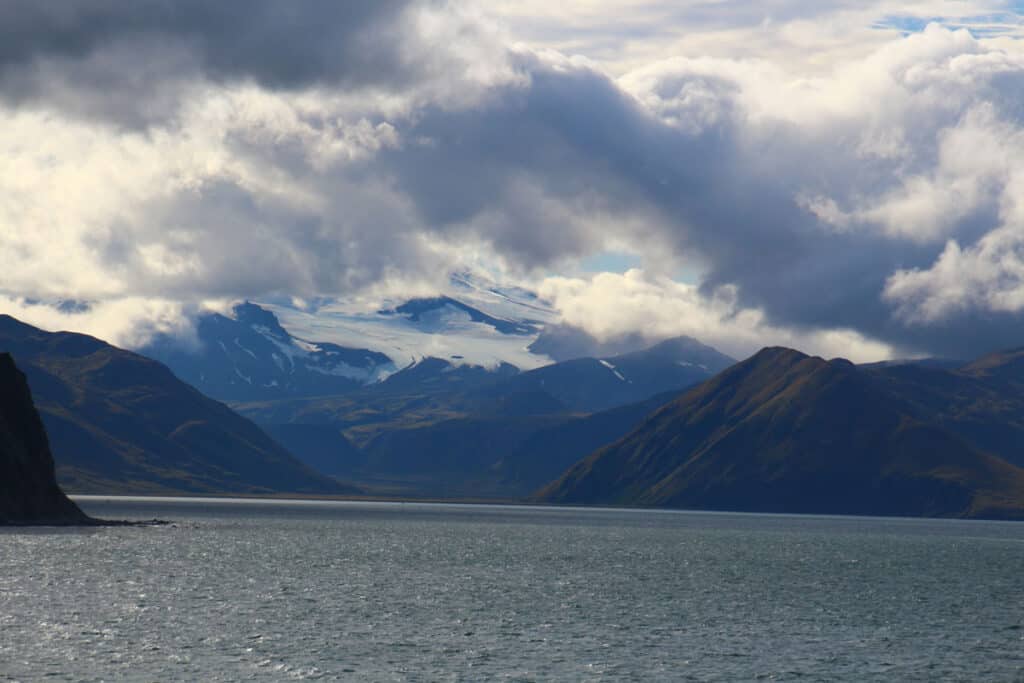
Makushin is a strato-volcano and has a caldera and a parasitic cone.
©iStock.com/Vipersniper
This volcano last had movement in 1995 and is still actively being monitored. It is a strato-volcano and has a caldera and a parasitic cone. A parasitic cone is a fake cone coming out of another part of the volcano and is not linked to a vent.
This means the parasitic cone has no access to magma and would not force any outward in the event of an eruption.
Okmok
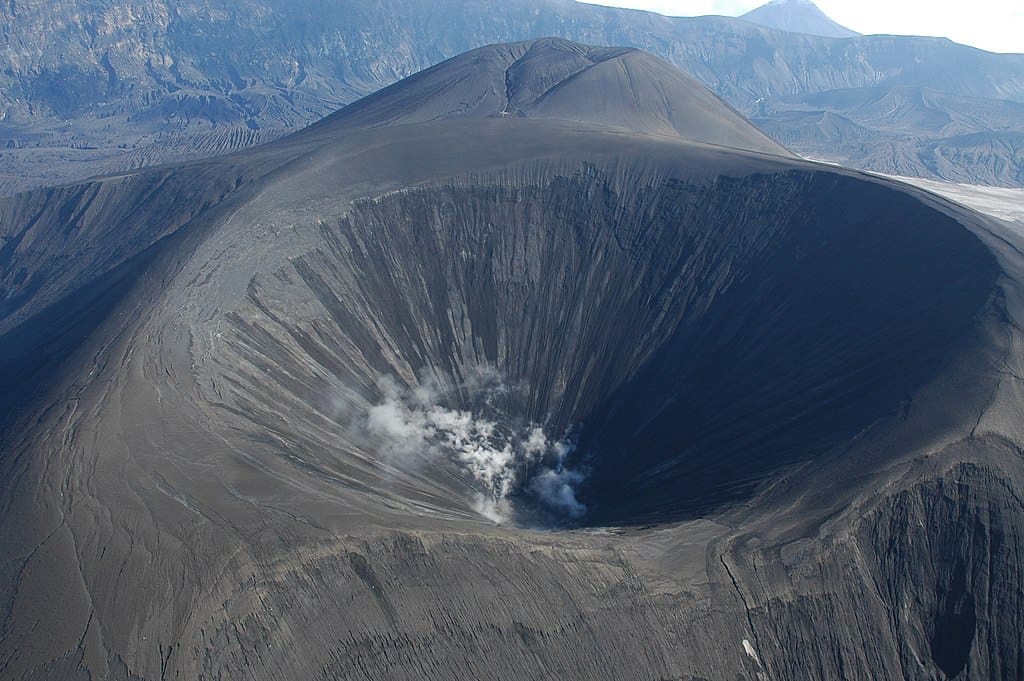
Okmok is a shield volcano that is lower to the ground.
©Christina Neal / This image is in the public domain in the United States because it only contains materials that originally came from the United States Geological Survey, an agency of the United States Department of the Interior. For more information, see the official USGS copyright policy.
Last erupting in 2008, Okmok is a shield volcano. A shield volcano is lower to the ground, and the pyroclastic flow reaches outward, forming a shield-like shape.
A pyroclastic flow is lava, ash, and gas, pushed slowly forward, which forms the volcano and decimates the ground beneath it. It also has a caldera nested between two parts of the volcano that are attached together.
Pavlof
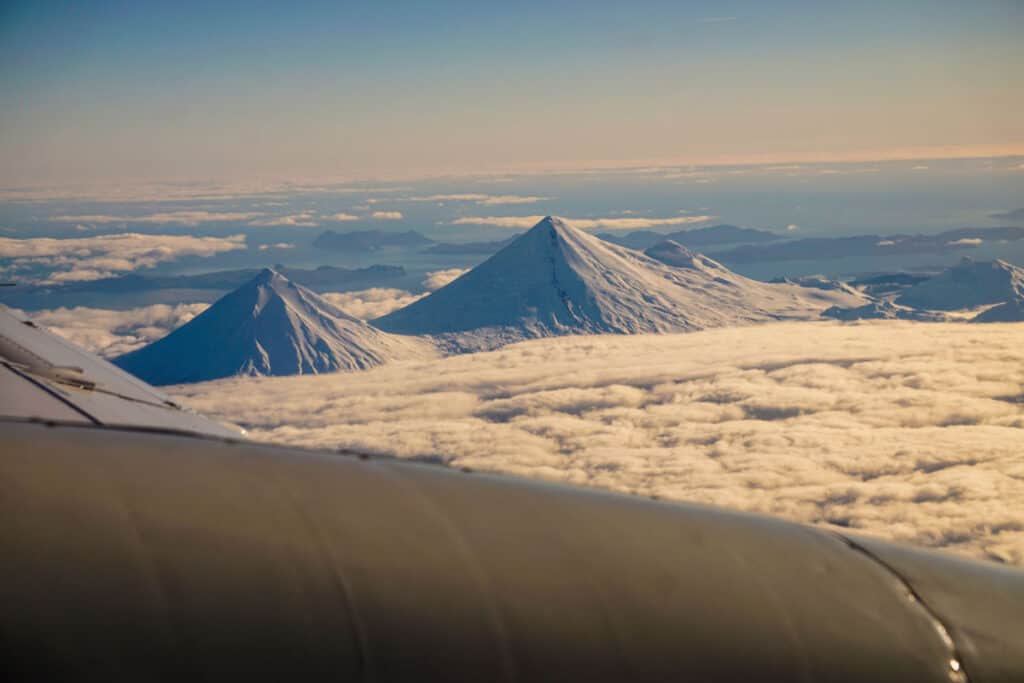
Pavlof has been active as recently as July 9, 2021, and has been threatening eruption.
©iStock.com/Daniel Mark Robertson
This volcano was active as recently as July 9, 2021. It is currently being monitored for more activity and has been threatening eruption. It is on the peninsula of Alaska and has had explosions recorded.
Pavlof Sister is located right beside it, so it is not alone in its activities, and they almost match up exactly symmetrical. Pavlof tends to erupt without any signs that it will, so it likes to surprise us with eruptions. It is not a massive threat to any local areas.
Shishaldin

Shishaldin is the tallest volcano located in Alaska and is kind of a North Star for those living in Alaska.
©NOAA Photo Library / flickr – License
Shishaldin roughly means “mountain I look for when I am lost,” so it is kind of like a North Star in Alaska. It is the highest point in the Aleutian Islands, which would account for its status as a north star. It is a stratovolcano that last had activity in July of 2019.
The cone of Shishaldin is globally the most symmetrical cone for any volcano. It has a lovely shield formed from glaciers, and it is no wonder that it is so easily spotted.
Veniaminof
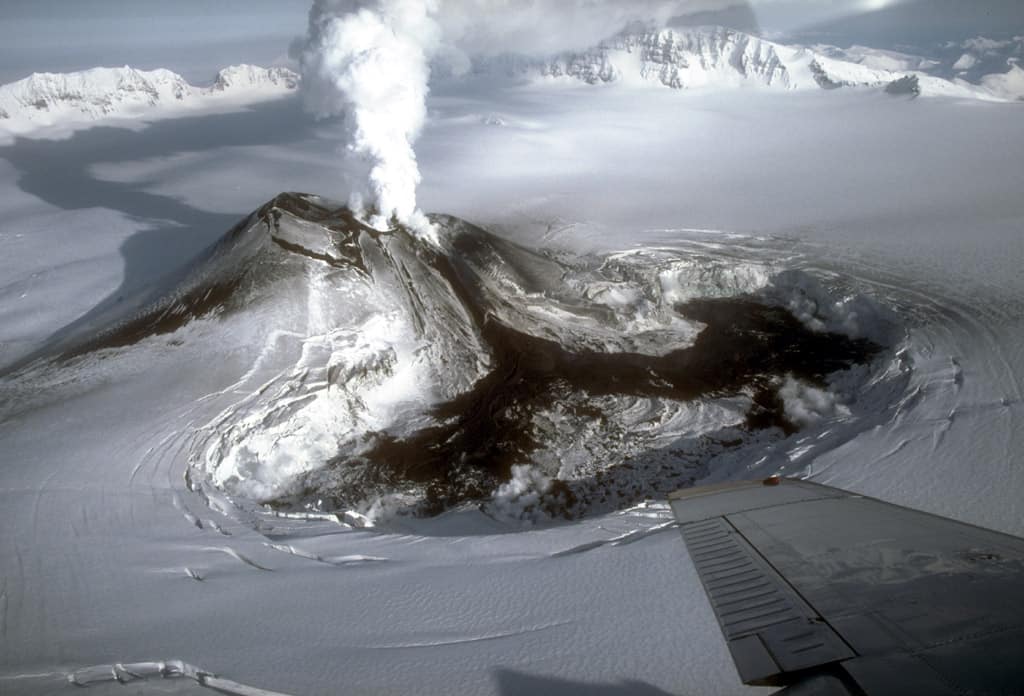
Veniaminof is second only to Shishaldin in height.
©M.E. Yount, U.S. Geological Survey / This image is in the public domain in the United States because it only contains materials that originally came from the United States Geological Survey, an agency of the United States Department of the Interior. For more information, see the official USGS copyright policy.
The last time Veniaminof was active was September 4, 2018. It is another strato-volcano of intense height and is second only to Shishaldin. It stands tall and imposing with a caldera at its summit.
The caldera has a cinder cone as well, posed off-center and emitting ash and steam.
List Of 130 Alaskan Volcanoes
These were just the ten most active volcanoes in Alaska. They radiate such power and beauty in a land of ice. The steam and ash of an eruption must be awe-inspiring, and they are far enough away from people that they don’t pose a threat.
90 of them have been active in the last 10,000 years don’t forget. With en of them active in more recent years, there’s much we can learn from these volcanoes.
As mentioned previously, here is the list of all 130 volcanoes to be found in the state of Alaska:
- Adagdak
- Akutan
- Alagogshak
- Amak
- Amchixtam Chaxsxii
- Amukta
- Andrew Bay volcano
- Aniakchak
- Atka
- Augustine
- Basalt of Gertrude Creek
- Behm Canal-Rudyerd Bay
- Black Peak
- Blue Mtn
- Bobrof
- Bogoslof
- Buldir
- Buzzard Creek
- Camille Cone
- Capital
- Carlisle
- Chagulak
- Chiginagak
- Churchill, Mt
- Cleveland
- Cone 3110
- Cone 3601
- Dana
- Davidof
- Denison
- Devils Desk
- Double Glacier
- Douglas
- Drum
- Duncan Canal
- Dutton
- Edgecumbe
- Emmons Lake Volcanic Center
- Espenberg
- Fisher
- Folsoms Bluff
- Fourpeaked
- Frosty
- Gareloi
- Gas Rocks, the
- Gilbert
- Gordon
- Gosling Cone
- Great Sitkin
- Griggs
- Hayes
- Herbert
- Iliamna
- Imuruk Lake Volc Field
- Ingakslugwat Hills
- Ingenstrem Depression Volcanic Field
- Ingrisarak Mtn
- Iron Trig cone
- Isanotski
- skut-Unuk River cones
- Jarvis
- Jumbo Dome
- Kagamil
- Kaguyak
- Kanaga
- Kasatochi
- Katmai
- Kejulik
- Kialagvik
- Kiska
- Klawasi Group
- Knob 1000
- Kochilagok Hill
- Koniuji
- Kookooligit Mountains
- Korovin
- Koyuk-Buckland volcanics
- Kukak
- Kupreanof
- Little Sitkin
- Lone basalt
- Lost Jim Cone
- Mageik
- Makushin
- Martin
- Moffett
- Monogenetic QT vents of WWVF
- Morzhovoi
- Nelson Island
- Novarupta
- Nunivak Island
- Nushkolik Mountain volcanic field
- Okmok
- Pavlof
- Pavlof Sister
- Prindle Volcano
- Rainbow River cone
- Recheshnoi
- Redoubt
- Roundtop
- Sanford
- Seguam
- Segula
- Semisopochnoi
- Sergief
- Shishaldin
- Skookum Creek
- SnowySpurr
- St. George volcanic field
- St. Michael
- St. Paul Island
- Steller
- Stepovak Bay 1
- Stepovak Bay 2
- Stepovak Bay 3
- Stepovak Bay 4
- Suemez Island
- Table Top Mtn
- Takawangha
- Tana
- Tanada Peak
- Tanaga
- Tlevak Strait
- Togiak volcanics
- Trader Mtn
- Trident
- Ugashik-Peulik
- Ukinrek Maars
- Uliaga
- Ungulungwak
- Hill-Ingrichuak Hill
- Unimak 5270
- Unnamed (near Ukinrek Maars)
- Veniaminof
- Vsevidof
- Westdahl
- Western Cones
- Wide Bay cone
- Wrangell
- Yantarni
- Yunaska
The photo featured at the top of this post is © Christina Neal / This image is in the public domain in the United States because it only contains materials that originally came from the United States Geological Survey, an agency of the United States Department of the Interior. For more information, see the official USGS copyright policy. / Original
FAQs (Frequently Asked Questions)
Which volcanoes are currently active in Alaska?
- Akutan
- Bogoslov
- Cleveland
- Gareloi
- Great Sitkin
- Makushin
- Okmok
- Pavlov
- Shishaldin
- Veniaminof
Which volcano in Alaska has been the most recently active?
Pavlof was active as recently as July 9, 2021.
Thank you for reading! Have some feedback for us? Contact the AZ Animals editorial team.






